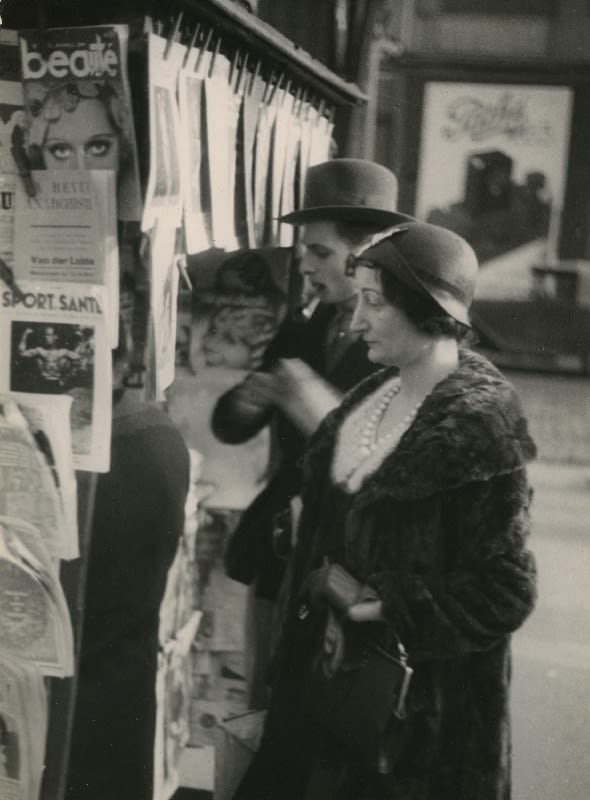Andre Kertesz 1894-1985
One of the most widely respected photographers of the twentieth century, Kertész (1894-1985) worked through a long career which took him from Hungary to Paris and then New York.
Engaged with realism and surrealism, Kertész' subjects included the streets around him as well as artist's studios and a famous series of surreal nudes that he named 'Distortions.'
While working as a clerk on the Budapest Stock Exchange from 1912 to 1914, Kertész began to experiment with photography. During World War I he served in the Hungarian army and saw action in central Europe, where he was severely wounded. He returned to the stock exchange, taking photographs in his spare time, and his photographs were occasionally printed in Hungarian magazines.
Because of the lack of artistic and political freedom in Hungary at the time, Kertész moved to Paris in 1925 to work as a freelance photographer. There he became friendly with many influential artists, including Fernand Léger, Marc Chagall, Piet Mondrian, and Tristan Tzara. Kertész's access to these individuals allowed him to create a definitive portrait of the Parisian cultural milieu of the period. In 1927 he had a well-received one-man show in Paris, and his photographs were shown the following year at the influential First Independent Salon of Photography.
In 1928 he bought a Leica, a small handheld camera that gave him the freedom to move about the streets of Paris and capture spontaneous moments of urban life, a subject that would fascinate him throughout his career. Kertész became a major contributor to the magazines Vu (which began publication in 1928) and Art et Médecine (which began publication in 1930) as well as other important illustrated periodicals in Europe, such as the Sunday Times.
In 1936 Kertész went to New York City to work for what was supposed to be a one-year project with the commercial Keystone Studios. With the advent of World War II, he remained in New York. From 1939 to 1949 he worked as a freelance photographer for American magazines such as Look, Harper's Bazaar, Vogue, and Town and Country.
In 1949 Kertész joined Condé Nast publications, under Alexander Liberman, and began to work mainly on House and Garden magazine, transforming its visual character. About 1962 he retired from commercial work and began a series of personal photography projects, earning the level of critical reception he had sought for decades. His work again focused on capturing the essence of a moment, this time often set within the bustling activity of New York. For one major project from this period he took photographs of street scenes from the window of his apartment overlooking Washington Square.
In another project he collected objects in front of this same window and created a series of still-life photographs.
Retrospectives of Kertész's work have been staged by the Museum of Modern Art (1964) and the Metropolitan Museum of Art (1985), both in New York City. Perhaps Kertész's single best-known photograph is Satiric Dancer (1926). The many books of his photographs include Day of Paris (1945), André Kertész, Photographer (1964), André Kertész: Sixty Years of Photography (1972), J'aime Paris: Photographs Since the Twenties (1974), Distortions (1976), and Kertész on Kertész: A Self-Portrait (1985).
James Hyman Photography is proud to feature vintage works by this illustrious photographer.
-

Andre Kertesz - Linda McCartney
1 - 31 May 2019Andre Kertesz was one of the greatest photographers in the history of the medium and a photographer greatly admired by Linda McCartney. Famed for his modernist photographs made in Paris in the 1920s and then in New York, Kertesz's works are tightly structured meditations on life in the modern metropolis....Read more -

Thinking Big
Large Scale Photographs from the Estate of Andre Kertesz 18 May - 30 Sep 2016After the Second World War Kertesz began increasingly to return to his earlier works to print them at an enlarged size or to print new pictures at an unprecedented scale. The exhibition begins with Kertesz famous distortions, and enlarged prints made in the 1940s. It then presents as a key...Read more -

Andre Kertesz in Europe
13 May - 13 Jun 2015The exhibition - the first of its kind to focus on Kertesz's European work along - spans the photographer's whole career and features well-known images as well as several unknown photographs which have never before been exhibited or published. Born in Hungary in 1894, Kertesz was one of the most...Read more





























